Next Generation Cell Free Protein Expression Kit (Wheat Germ) (CFPS700) PROTOCOL
Introduction
Protein synthesis using cell-free protein synthesis reagent kit consists of three stages: preparation of transcription template, transcription and translation. For the use of the translation reagent set, please refer to section “Translation”.

In preparation of transcription template, it is necessary to prepare a primer in advance. In the different attachment, five different tag sequences are shown, and by carrying out PCR twice, it is possible to efficiently create a transcription template containing multiple tag sequences. Also, it is possible to tag both N-terminal and C-terminal. The primer list is given below.
The 2-step PCR is the first step in the protocol of CFPS700 kit to generate the DNA template to be used in the following transcription and translation. The 1st PCR aims to connect the target ORF sequence with the 2nd forward/reverse primers (please see the diagram below). Therefore, the 1st PCR forward/reverse primers need to be target gene specific that overlap with the N-terminal and C-terminal sequences of the ORF of the target gene. There are two sets of forward and reverse primer sets in the 2nd PCR. The two reverse 2nd PCR primers and one forward 2nd PCR primers are universal primers. The other forward 2nd PCR primer contains a tag sequence, such as His-, FLAG-, or MYC-tag, therefore can differ from one another depending on your tag choice.
In the detailed protocol below, overlapping length between 1st gene specific primers and ORF is set at 18 bp as the default. However, the overlapping length can be extended to 30 bps, giving multiple options for primer. The selection of the primer set for the 1st PCR is critical. If not carefully done, it would result in less efficient or even failed 1st PCR, subsequently 2nd PCR, and ultimately failed protein translation. Please use the Primer Design Tool (right-click and download the Excel file) for the 1st PCR to design your 1st PCR primer set. The instruction for how to use this tool is provided here.”
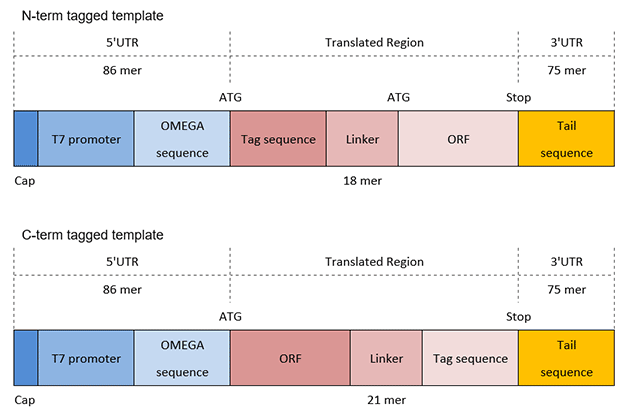
In this protocol, we show the PCR program when using Toyobo Co., Ltd. KOD®-Plus-Neo, Takara Bio Inc. PrimeSTAR®, PrimeSTAR® Max as PCR enzymes.
Primer Design
Structure of N-Terminal TAG DNA Template
The structure of N-terminal Tag DNA template and the sequence of each part are shown in Figure 1 and Table 1. Primer design and PCR are more complicated than usual because of the long sequence added to the prepared ORF.
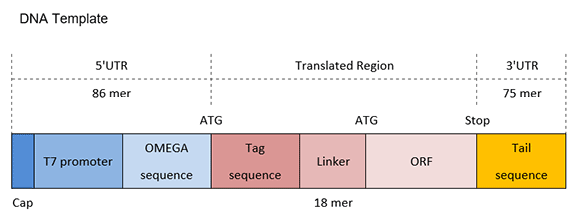
Figure 1. Structure of N-terminal Tag
Procedure for Preparation of Primer for N-Terminal TAG Transcription Template
Since PCR is carried out in two stages, 1st PCR and 2nd PCR, multiple primers are required. (Figure 2).
The Primer List (e.g His-tag insertion) is as shown in Table 2. Tag refferred in red (Table 2) can be change to other Tag .
Please note that Reverse primer is complementary to the sequence of Table 1.
In the case of non-Tag, please leave the Linker as it is.
The Linker sequence can be changed to an appropriate protease recognition sequence.
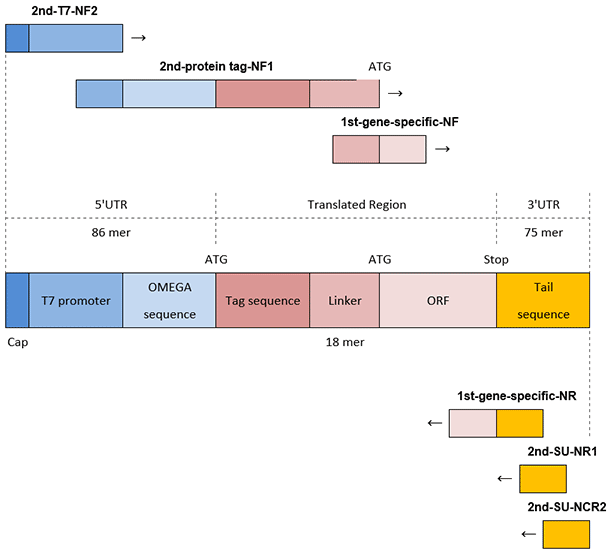
Figure 2. PCR of N-terminal tag DNA template
Structure of C-Terminal TAG DNA Template
The structure of C-terminal Tag DNA template and the sequence of each part are shown in Figure 3 and Table 3.
Same as with N-terminal tag, Primer design and PCR are more complicated than usual because of the long sequence added to the prepared ORF

Figure 3. C-terminal tag DNA template
Procedure for Preparation of Primer for C-Terminal TAG Transcription Template
Since PCR is carried out in two stages, 1st PCR and 2nd PCR, multiple primers are required. (Figure 4).
The Primer List (i.e. His-tag insertion) is shown in Table 4. Tag in red (Table 3) can be changed to other Tag sequences.
Please note that Reverse primer is complementary to the sequence of (Table 3)
In the case of non-Tag, please leave the Linker as it is.
The Linker sequence can be changed to an appropriate protease recognition sequence.
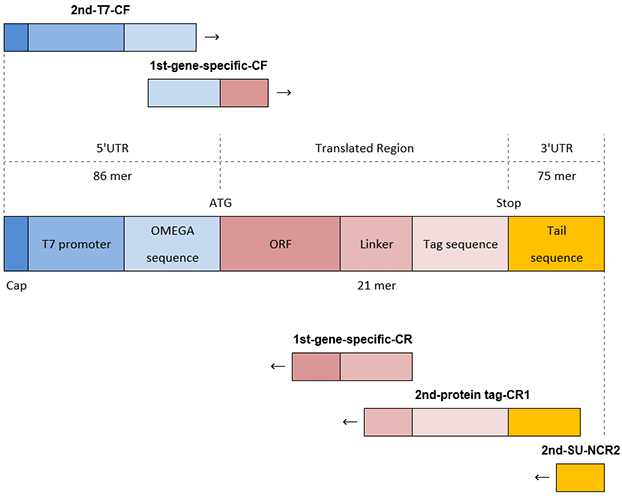
Figure 4. PCR of C-terminal tag DNA template
Production of Transcription Template
Detection of 1st PCR and 2nd PCR Product
Please check the PCR products after 1st PCR and 2nd PCR as follows.
- Prepare a TAE agarose gel at a concentration according to the DNA size and set in electrophoresis.
- Load the 3 μL sample PCR without purification into the agarose gel above.
- After completion of electrophoresis, the agarose gel is stained with Ethidium Bromide for 30 minutes.
- Fluorescence detection of DNA is performed by a transilluminator.
【Example of checking PCR product for N-terminal tag】
N-terminal template 1
1st and 2nd PCR products
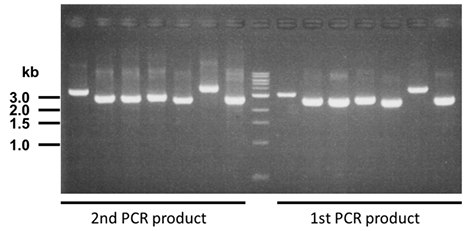
- Exposure time: 1/8 sec
- Applied: 5 µL
- 1.5% TAE agarose gel
- Quick-Load 1 kb DNA Ladder (BioLabs): 5 µL
- Ethidium bromide staining: 30 min
As a result of confirmation of PCR Product, if problem occurs, please review again in the following order
- Confirm PCR program
- Check composition of the reaction solution preparation
- Confirm PCR prime
1st PCR
The composition and reaction program for one sample are shown in the table below.
It is also recommended to change the description program in consideration of the amplification efficiency etc.
After completion of 1st PCR reaction, check 1st PCR product (3 μL) using agarose gel electrophoresis.
In the following program, 1st-gene-specific-F and 1st-gene-specific-R indicate 1st-gene-specific-NF, 1st- gene-specifc-NR in the case of N-terminal tag transcription template, For C-terminal tag transcription template they are 1st-gene-specific-CF and 1st-gene-specific-CR respectively.
Composition and PCR program when using KOD-Plus-Neo
Composition and PCR program when using PrimeSTAR
Composition and PCR program when using PrimeSTAR Max
2nd PCR
Please use 1st PCR Product in unpurified and unconcentrated state for 2nd PCR
After 2nd PCR reaction, check 2nd PCR product (3 μL) using agarose gel electrophoresis.
It is also recommended to change the description program in consideration of the amplification efficiency etc.
*Normally, 1 μL of 1st PCR product is used for 2nd PCR.
Each program of 2nd PCR
Following program is common for N-terminal tag and C-terminal tag.
Composition for N-terminal tag of 2nd PCR
Composition for C-terminal tag of 2nd PCR
Transcription Reaction
- Tap the prepared transcription reaction solution lightly and use tabletop centrifuge to drop the solution that attached to the wall gently.
- Close the cap securely to prevent evaporation of the solution.
- Incubate in water bath or incubator at 37 °C for 3 hours.
*The standard for reaction time is 3 hours up to 6 hours at most.
Transcription Purification
- After completion of the transcription reaction, load 1 μL transcription sample to agarose gel electrophoresis.
- Add 10 µL of 4 M ammonium acetate per one sample (25 μL), mix well, add 100 μL of 100% ethanol, inverted the tube, then use tabletop centrifuge for several seconds. Let stand for 20 minutes on ice.
Ammonium acetate is essential as neutralizing reagent. Please note that mRNA is inactivated and proteins cannot be synthesized when purified with reagents for purification, trizole, ammonium sulfate, etc. - Centrifuge at 15,000 rpm for 20 minutes at 4 °C
- Discard the supernatant with a pipete and use tabletop centrifuge for several seconds. Discard the supernatant again by careful aspiration with a pipette. At this time, be careful to not touch the pellet of the sample.
- Leave the pellet until dries. Keep the lid of the tube open, please be careful not to contaminate impurities, dust, brushes.
*Nucleic acid dryer is not allowed - Add 80 μL of RNase-free water (DEPC water) per one sample (25 μL of transcription reaction solution) to dissolve the mRNA pellet.
Suspend the pellet well and use it as an mRNA solution
* Be careful as mRNA may adhere to the wall of the tube in a difficult state to check
Confirmation of Transcription
- Confirmation of transcription (mRNA)
After completion of purification, confirm the mRNA by electrophoresis.
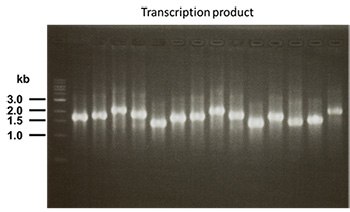
- Exposure time: 1/15 sec
- Applied: 1 µL
- 1.5% TAE agarose gel
- Quick-Load 1 kb DNA Ladder (BioLabs): 3 µL
- Ethidium bromide staining: 20 min
- Concentration measurement of transcription.
When measuring the concentration, purify phenol / chloroform system separately from the sample for translation.
Yield of one target mRNA from the transcription reaction is > 25 µg.
Depending on the target protein, mRNA may be synthesized in large quantities in the transcription reaction, but when mRNA is subjected to the translation reaction in a large amount (40 µg or more), on the contrary, the protein yield drops extremely, or the full length protein can not be obtained. Therefore, We suggest you can measure the concentration, and in the case of 110 μL of translation solution in the next chapter, as mRNA solution. Please prepare and supply to 25 ~ 40 µg / 80 µL, preferably 30 ~ 35 µg / 80 µL of mRNA for translation per 110 µL sample size.
In the case of coexpression using heterologous mRNA such as heterodimer, for example, coexpression of protein with molecular weight A and molecular weight B, making the ratio of each mRNAs is A: B respectively and total amount of mRNA about 30 to 35 µg / 80 µL, improves multimer of them.
Translation
Preparation of translation reaction solution
Prepare the translation reaction solution with 1.5 mL tube or PCR tube as follows.
Prepare reagents other than mRNA first and make it to room temperature, then added to the mRNA solution and resuspend gently so as not formed foam.
When mRNA concentration is unknown, it is suggested that whole mRNA synthesized by one transcription reaction is added to one translation reaction solution.
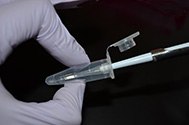
Please note that adding wheat germ extract more than 10 µL for 110 µL solution could decrease the yeild of translation product.
Translation reaction (simple batch method)
- Incubate the tube at 16 °C and let it react overnight (over 10 hours)
- Gently mix the sample by pipete, collected in an Eppendorf tube, centrifuged at 15,000 rpm for 10 minutes at 4 ° C. The supernatant is stored at -80 ° C
Scale-Up
In this protocol, 1 translation reaction is 110 µL, but scale-up is possible.
For scaleup, please increase the ratio of translation reaction system as it is.
e.g.) When translation reaction 110 µL is scaled up to 220 µL, the composition is
If you scaled up, the yield of the target protein may be improved.
e.g.) In the case one translation reaction of 110 µL have a yield 10 µg, one translation reaction of 550 µL improves the yield per reaction solution with the target yield, about 70 µg
Translation reaction (dialysis method)
Dialysis method can be used instead of simple batch method. In the dialysis method, insert the translation solution into the inside of the dialysis cup (sample solution), and use additional Amino acid mix as the dialysis external solution. Dialysis external solution is generally 20 times to 100 times the capacity.
When using Slide-A-Lyzer™ Mini dialysis tool (sample 0.1 mL, molecular weight cut off 3.5 K) manufactured by Thermo Fisher Scientific Inc.
- Place 2 mL of Amino Acid Mix into 1 well of a 24-well titer plate, diluted 4 times with ultrapure water into, and cover the plate.* Since 2 mL Eppendorf tube matches the dialysis cup, the dialysis method can be do with 2 mL Eppendorf tube.
- Squeeze the dialysis cup into the lid of the plate.
- Take the total volume of 110 μL of the prepared translation reaction solution and transfer to dialysis cup gently so bubbles do not enter on to the dialysis cup, two-step pushing of the pipette can causes foaming. Then close the lid of the dialysis cup. At this time, please set the level of the sample solution (reaction layer) and the level of the external dialysate (Amino Acid Mix) are at the same level or the level of the sample solution is slightly lower.
- Incubate at 16 °C and let it react overnight (over 10 hours)
Moreover, by drilling 9mm hole in 24-well titer plate can fit to dialysis cup, but if it is difficult to drill, use a floater to microtube.
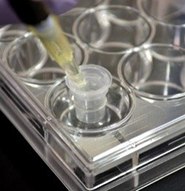
Confirmation of Protein
Confirm the translation product by acrylamide gel electrophoresis as follows.
- After completion of the translation reaction, fill up the translation reaction solution with ultrapure water up to 3 volumes and stir gently.
- Centrifuge at 15,000 rpm for 20 min at 4 °C, collect supernatant.
- Load about 1-2 µL of sample to acrylamide gel, then electrophorese
- Detect according the staining method.
About the above procedure
Procedure 1. The purpose of fill up is to save the detection sample, to avoid overloading, and to solubilize the nonsolubilized compound. If it is Fill up up to three times, the buffer capacity of the reaction solution is maintained, but be careful when filling beyond this. If you do not need it, skip this step.
Procedure 2. Regarding precipitates, in addition to components derived from Wheat Germ, non - solubilized objects may also be included. If necessary, resuspend the precipitate with an appropriate Buffer to recover the desired product. If there is any doubt about the amount of target product recovered from the supernatant, this will grasp the solubilization rate and improvisation by optimizing the translation reaction solution.
Procedure 3. For electrophoresis samples, Western blot, silver staining, CBB staining, both are detected at approximately 1-2 µL. In detection other than immunostaining, Wheat Germ components are also detected, so loading large amounts of samples is not recommended.
The following is the result of synthesizing FLAG® fusion protein using this kit and detecting these proteins by western blot using anti-FLAG® antibody.
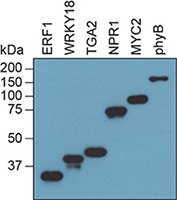
Next Generation Cell Free Protein Expression Kit (Wheat Germ) (CFPS700) are for research use only.
KOD® and KOD-Plus-Neo are registered trademarks or trademarks of Toyobo Co., Ltd.
PrimeSTAR® and PrimeSTAR® MAX are registered trademarks or trademarks of Takara Bio Inc. FLAG® is a registered trademark of Sigma-Aldrich Co. LLC. Slide-A-Lyzer ™ is a trademark of Thermo Fisher Scientific Inc.
Other company names and product names mentioned may be other trademarks and registered trademarks of each company.
The reagents, products, etc., are not always indicated by trademark indication (®, ™).
Materials List
To continue reading please sign in or create an account.
Don't Have An Account?